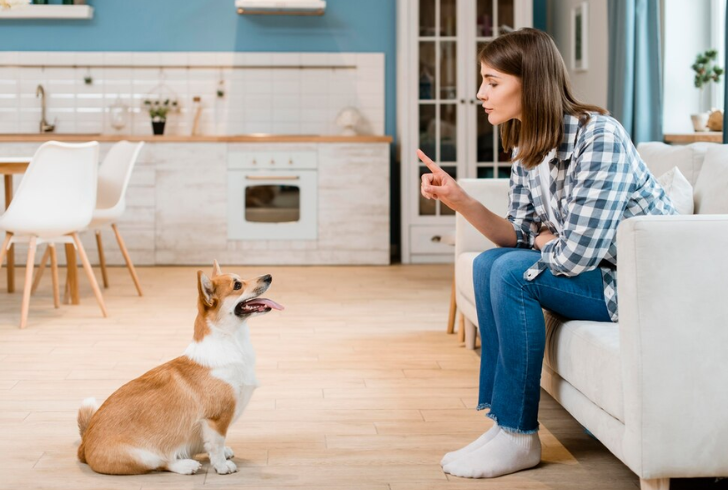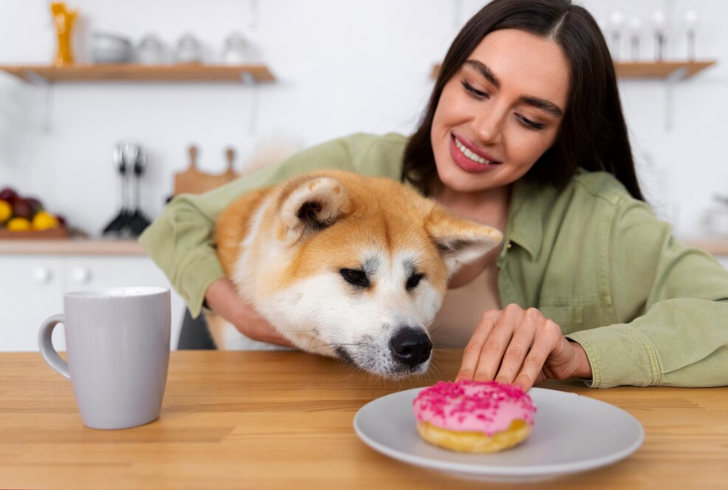5 Creative Indoor Dog Training Ideas When You Can’t Go Outside
When it’s time to stay indoors with your dog, training doesn’t have to stop. Whether due to bad weather, health reasons, or simply not having access to outdoor spaces, indoor dog training can be just as effective in helping your dog continue learning and growing. The key is to keep your dog’s mind and body engaged, ensuring they get the mental stimulation and physical exercise they need.
While outdoor training offers its own set of challenges and opportunities, indoor environments can provide the perfect space for practicing new skills and reinforcing good behavior. In fact, some dogs thrive in smaller, more controlled spaces where distractions are limited.
Here’s how to keep the momentum going with indoor dog training.
1. Training New Skills in Small Spaces

Freepik | Keep your dog engaged indoors by teaching new skills. Basic commands like ‘sit,’ ‘stay,’ and ‘down’ are a great starting point.
One of the best ways to keep training progress going indoors is to focus on mastering new skills. While it might seem like a limited space could hold you back, there are plenty of simple tasks you can teach your dog right from your living room. Start with the basics like “sit,” “stay,” and “down.” These are excellent foundational skills that can be practiced in small areas without needing much room to move.
If your dog is ready for more advanced skills, consider teaching them to heel. This might involve rearranging some furniture to create obstacles that challenge your dog’s movements. A small space doesn’t mean small progress—it’s a great way to fine-tune skills that might need a bit more focus.
2. Keeping Their Minds Active
Training doesn’t always have to involve traditional obedience work. Mental stimulation is just as important, and there are plenty of ways to give your dog’s brain a workout indoors. A great way to engage your dog mentally is through treat puzzles or hide-and-seek games. You can hide treats in various spots around the house and have your dog track them down. Alternatively, if your dog has mastered the “stay” command, you can hide and then call them to “find” you.
These activities provide your dog with mental challenges that prevent boredom and can help prevent behavioral issues. Not only are they fun, but they strengthen your dog’s cognitive abilities as well.
3. Indoor Exercise for Active Dogs
Indoor dog training isn’t limited to learning commands and playing brain games—it can also involve physical activity to burn off excess energy. If you have a small dog, playing fetch down a hallway can be a great way to get them moving without leaving the house. For larger dogs, consider activities like indoor dog dancing or canine freestyle. These involve precise movements and can be a fun way to keep your dog physically engaged.
Even practicing basic obedience can count as a form of exercise. Running through commands like “sit,” “down,” “come,” and “stay” in quick succession can be a good way to keep your dog active and engaged. If your dog enjoys following a routine, try including a short jog with them to help both of you get moving.
4. Continue Sports Training or Try Something New
If your dog enjoys sports like agility or scent work, there’s no need to put those skills on hold just because you’re stuck indoors. With a little creativity, you can replicate elements of these sports right in your living room. For example, you can create a DIY agility course by using broomsticks, cushions, and even furniture to create obstacles. If your dog loves scent work, hide treats in different boxes or containers around the house and let them use their nose to find them.
If you’re new to dog sports, this is a great time to explore them. There are many online resources that can help you get started with activities like scent training, rally obedience, or even dog dancing. These activities not only provide mental stimulation but also help you bond with your dog in meaningful ways.
5. Get Creative With DIY Toys and Treats

Freepik | Bond with your furry friend by making homemade treats and toys together!
Being indoors doesn’t mean you can’t introduce new activities. Consider making your own dog toys or treats to keep things interesting. There are plenty of simple recipes online for dog-friendly treats that use everyday pantry items, such as peanut butter and oats. These homemade snacks not only taste great but can be a fun activity for you and your dog to do together.
In addition to treats, you can create toys using items you already have in your home. Empty toilet paper rolls or cardboard boxes make excellent makeshift treat dispensers. Simply stuff them with some treats, and your dog will have a blast trying to get them out.
Make the Most of Indoors Dog Training
Training your dog indoors doesn’t mean you have to give up on progress or fun. In fact, it can be an excellent opportunity to focus on new skills, mental challenges, and physical exercises. By consistently incorporating these activities into your daily routine, your dog will stay mentally and physically fit while continuing to build on the training you’ve worked so hard to achieve.
Whether you’re keeping up with basic commands or exploring new activities, remember that training should always be fun, rewarding, and engaging for both of you. After all, a well-trained dog is a happy dog!